The Poor Clare Sisters, living a secluded life in a monastery on Fort Myers Beach, are examples for all to follow, shaking off their worldly burdens to live as St. Clare of Assisi called, in cloister, devoting their life to serve as the Lord called.
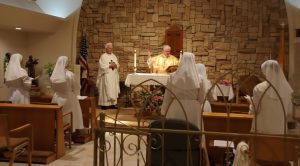 Bishop Frank J. Dewane expressed his profound gratitude to the Poor Clare Sisters for their response to God while remarking how the ongoing global pandemic has forced many into isolation, which he prays has encouraged the faithful to use that time growing closer to the Lord.
Bishop Frank J. Dewane expressed his profound gratitude to the Poor Clare Sisters for their response to God while remarking how the ongoing global pandemic has forced many into isolation, which he prays has encouraged the faithful to use that time growing closer to the Lord.
The Bishop celebrated Mass on Aug. 11, 2020, the Feast of St. Clare, for the religious sisters at the San Damiano Monastery of St. Clare on Fort Myers Beach.
Abbess Sister Mary Frances Fortin and the other religious sisters at the Monastery, expressed their appreciation for the Bishop’s presence, particularly on the Feast Day of their Founder, which is an annual occasion.
“We are deeply grateful to have Bishop here with us every year, but his presence has a greater meaning to us during this pandemic,” Sister Mary Frances said. “The continued support we receive from the Bishop and Diocese is overwhelming.”
The Mass was celebrated without the normal standing-room-only congregation as the Chapel is too small to accommodate the faithful and still maintain social distancing.
“We miss the people who come to visit,” Sister Mary Frances said of those who would attend the daily Mass or come to pray in the Chapel. “Our prayers are with everyone who is suffering through these difficult times and we turn to the Lord in joyful hope that will we be able to open our doors again soon.”
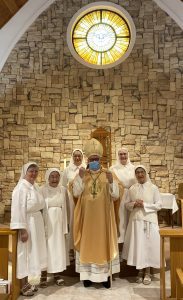
Bishop Dewane said the good work of Poor Clare Sisters, “through your prayers and your example that should inspire all to devote one’s life in service to the Lord.”
The Poor Clare religious community of women was begun 800 years ago when Chiara Offreduccio, a young noble woman of Assisi, Italy, cast off her rich garments and donned the simple garb of St. Francis of Assisi to live, as he did, the Holy Gospel of our Lord Jesus Christ.
The Poor Clare Sisters have called Fort Myers Beach their home since 1988. The Monastery became independent in 2009. Although the Sisters never solicit donations, many parishioners bring them groceries and send them money each month.
The daily life of the Poor Clare Sisters is set into a traditional monastic framework of prayer and work. Holy Mass and Liturgy of the Hours are the anchor of their day. Outside these times, the sisters engage in all the ordinary tasks of life in a spirit of sisterly sharing, joy and peace. A sister might be found packing up an order of hosts for one of the local parishes, taking care of the altar, sweeping the cloister walk or doing some laundry. Or you may find a sister at a desk, doing bookkeeping, answering mail, preparing spiritual cards or planning the liturgy.
While the Chapel is currently closed to the public due to the pandemic, you can contact the Poor Clare Sisters by calling 239-463-5599, emailing prayer requests to saintclare@comcast.net, or by visiting www.fmbpoorclare.com.
Donations in support of the Poor Clare Sisters can be sent to: San Damiano Monastery of St. Clare, 6029 Estero Blvd., Fort Myers Beach, FL 33931.
Prayer to St. Clare
“O glorious Saint Clare, God has given you the power of working miracles and the favor of answering the prayers of those who invoke your assistance in misfortune, anxiety and distress; we beseech you, obtain for us from Jesus, through Mary, what we beg of you so fervently and hopefully if it be for the greater honor and glory of God and for the good of our souls. Amen.”








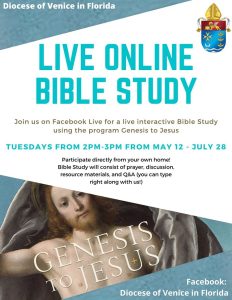 A Bible Study will be offered online through the Diocese of Venice Facebook Live on Tuesdays May 12 through July 28 using the program “Genesis to Jesus” from the St. Paul Center for Biblical Theology. Each session will begin at 2:00 p.m. Join by going to
A Bible Study will be offered online through the Diocese of Venice Facebook Live on Tuesdays May 12 through July 28 using the program “Genesis to Jesus” from the St. Paul Center for Biblical Theology. Each session will begin at 2:00 p.m. Join by going to 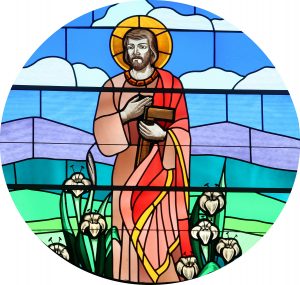

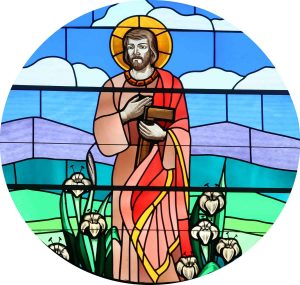
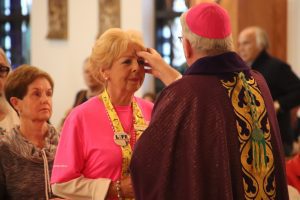 These words from Pope Francis should resonate with all Catholics and serve to remind us that the coming Liturgical Season has great significance and meaning.
These words from Pope Francis should resonate with all Catholics and serve to remind us that the coming Liturgical Season has great significance and meaning. During Lent, it is common to participate in a retreat or the Stations of the Cross, allowing the opportunity for one to refocus on the Lord in different ways. Check with your local Parish for these and other Lenten activities.
During Lent, it is common to participate in a retreat or the Stations of the Cross, allowing the opportunity for one to refocus on the Lord in different ways. Check with your local Parish for these and other Lenten activities.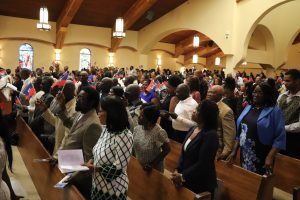 Nearly 1,000 people from throughout the Diocese of Venice attended the Mass which was celebrated by Most Rev. Max Leroy Mésidor, Archbishop of Port-Au-Prince, Haiti, with Bishop Frank J. Dewane in attendance. There were several additional priests from the Diocese of Venice who concelebrated as well as priests from St. Leo the Great Parish
Nearly 1,000 people from throughout the Diocese of Venice attended the Mass which was celebrated by Most Rev. Max Leroy Mésidor, Archbishop of Port-Au-Prince, Haiti, with Bishop Frank J. Dewane in attendance. There were several additional priests from the Diocese of Venice who concelebrated as well as priests from St. Leo the Great Parish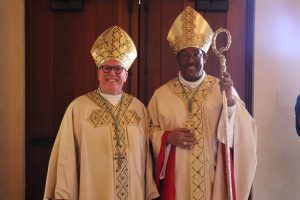 The Archbishop encouraged those gathered to remember the sacrifice of Haitians and to use the example of Mary, for she said ‘Yes’ to God with courage and grace. He added that they should feel confident in relying on Mary, the Holy Mother of God, to give them the strength to be sons and daughters of Jesus Christ.
The Archbishop encouraged those gathered to remember the sacrifice of Haitians and to use the example of Mary, for she said ‘Yes’ to God with courage and grace. He added that they should feel confident in relying on Mary, the Holy Mother of God, to give them the strength to be sons and daughters of Jesus Christ.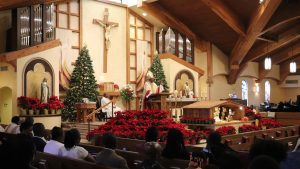 In a gesture of gratitude toward Bishop Dewane, Archbishop Mésidor noted that the Haitian Catholic Community within the Diocese of Venice is in good and capable hands and thanked Bishop Dewane for his support.
In a gesture of gratitude toward Bishop Dewane, Archbishop Mésidor noted that the Haitian Catholic Community within the Diocese of Venice is in good and capable hands and thanked Bishop Dewane for his support.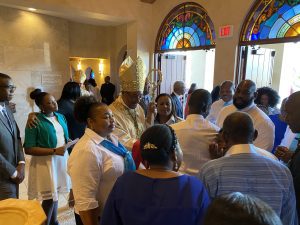 Bishop Dewane also thanked and recognized the Haitian priests serving in the Diocese for their continued dedication and passion for caring for the faithful, in particular those in the Haitian community. “The work you do does not go unnoticed,” the Bishop added.
Bishop Dewane also thanked and recognized the Haitian priests serving in the Diocese for their continued dedication and passion for caring for the faithful, in particular those in the Haitian community. “The work you do does not go unnoticed,” the Bishop added.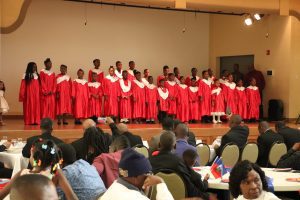 For the Haitian community, Jan. 1 is both a spiritual day, and an emotional day commemorating such an important day in their homeland. It was in 1803 that the Haitians defeated the largest and most powerful army at the time, the army of Napoleon, in Cap-Haitien. Haiti became the second country in the Americas to declare its Independence.
For the Haitian community, Jan. 1 is both a spiritual day, and an emotional day commemorating such an important day in their homeland. It was in 1803 that the Haitians defeated the largest and most powerful army at the time, the army of Napoleon, in Cap-Haitien. Haiti became the second country in the Americas to declare its Independence.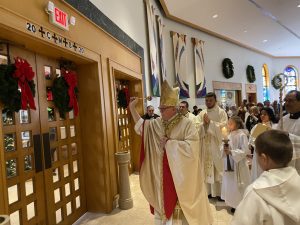 On Jan. 5, the Feast of the Epiphany of the Lord, the Feast Day of Epiphany Cathedral in Venice, Bishop Frank J. Dewane presided over a tri-lingual Mass (English, Spanish and Polish). This annual tradition includes the different language communities that are based at the Cathedral. At the beginning of the Mass, Bishop Dewane blessed the Cathedral where it is inscribed 20+C+M+B+20 (the year and the initials of the three magi) above the main interior entrance to the Church.
On Jan. 5, the Feast of the Epiphany of the Lord, the Feast Day of Epiphany Cathedral in Venice, Bishop Frank J. Dewane presided over a tri-lingual Mass (English, Spanish and Polish). This annual tradition includes the different language communities that are based at the Cathedral. At the beginning of the Mass, Bishop Dewane blessed the Cathedral where it is inscribed 20+C+M+B+20 (the year and the initials of the three magi) above the main interior entrance to the Church.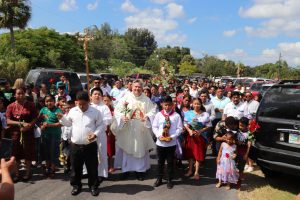 From Oct. 5-7 a celebration of Our Lady of the Rosary, Patroness of Guatemala, took over the community with a vigil, prayers, procession, food, music, dancing and even a few fireworks.
From Oct. 5-7 a celebration of Our Lady of the Rosary, Patroness of Guatemala, took over the community with a vigil, prayers, procession, food, music, dancing and even a few fireworks.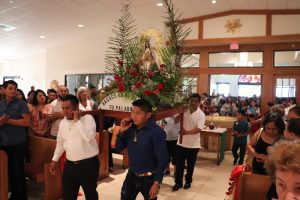 Father Patrick O’Connor, Oblate of St. Francis de Sales, Pastor of Jesus the Worker, passed out blessed rosaries to the younger children before the procession.
Father Patrick O’Connor, Oblate of St. Francis de Sales, Pastor of Jesus the Worker, passed out blessed rosaries to the younger children before the procession.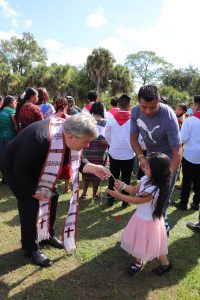 After the Mass, the celebration continued in the Parish Hall with traditional Guatemalan foods and dancing. There was also the selection of a Mayan princess from among the young ladies of the parish. The celebration concluded with a traditional Guatemalan community dance with music from the national instrument of Guatemala, the marimba. A more subdued celebration took place on Oct. 7, the Feast Day of Our Lady of the Rosary.
After the Mass, the celebration continued in the Parish Hall with traditional Guatemalan foods and dancing. There was also the selection of a Mayan princess from among the young ladies of the parish. The celebration concluded with a traditional Guatemalan community dance with music from the national instrument of Guatemala, the marimba. A more subdued celebration took place on Oct. 7, the Feast Day of Our Lady of the Rosary.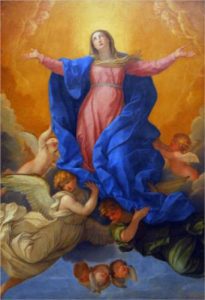
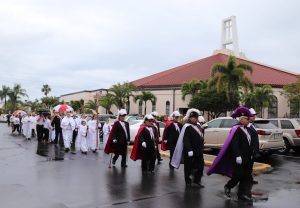
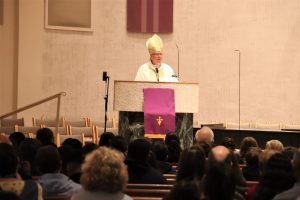
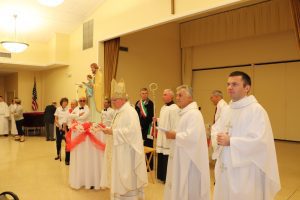 The tradition of the “St. Joseph Table” of food (“la tavala di San Giuseppe”) has its origins in Sicily as part of a Middle Ages celebration of the ending of a drought where food – bread in particular – is brought to be shared among the townsfolk.
The tradition of the “St. Joseph Table” of food (“la tavala di San Giuseppe”) has its origins in Sicily as part of a Middle Ages celebration of the ending of a drought where food – bread in particular – is brought to be shared among the townsfolk.